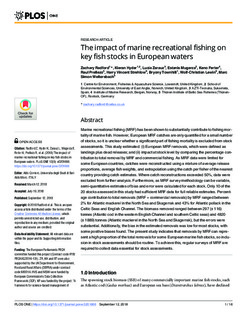| dc.description.abstract | Marine recreational fishing (MRF) has been shown to substantially contribute to fishing mortality of marine fish. However, European MRF catches are only quantified for a small number of stocks, so it is unclear whether a significant part of fishing mortality is excluded from stock assessments. This study estimated: (i) European MRF removals, which were defined as landings plus dead releases; and (ii) impact at stock level by comparing the percentage contribution to total removal by MRF and commercial fishing. As MRF data were limited for some European countries, catches were reconstructed using a mixture of average release proportions, average fish weights, and extrapolation using the catch per fisher of the nearest country providing catch estimates. Where catch reconstructions exceeded 50%, data were excluded from further analysis. Furthermore, as MRF survey methodology can be variable, semi-quantitative estimates of bias and error were calculated for each stock. Only 10 of the 20 stocks assessed in this study had sufficient MRF data for full reliable estimates. Percentage contribution to total removals (MRF + commercial removals) by MRF ranged between 2% for Atlantic mackerel in the North Sea and Skagerrak and 43% for Atlantic pollack in the Celtic Seas and English Channel. The biomass removed ranged between 297 (± 116) tonnes (Atlantic cod in the western English Channel and southern Celtic seas) and 4820 (± 1889) tonnes (Atlantic mackerel in the North Sea and Skagerrak), but the errors were substantial. Additionally, the bias in the estimated removals was low for most stocks, with some positive biases found. The present study indicates that removals by MRF can represent a high proportion of the total removals for some European marine fish stocks, so inclusion in stock assessments should be routine. To achieve this, regular surveys of MRF are required to collect data essential for stock assessments. | nb_NO |
